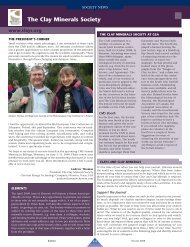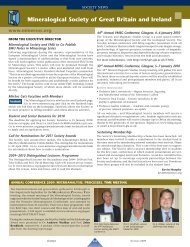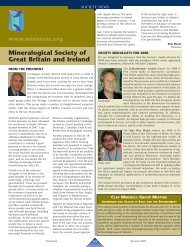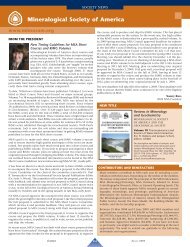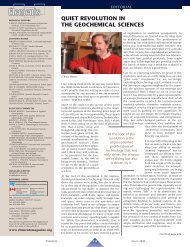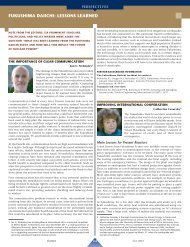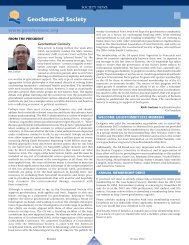MinSocAm - Elements Magazine
MinSocAm - Elements Magazine
MinSocAm - Elements Magazine
Create successful ePaper yourself
Turn your PDF publications into a flip-book with our unique Google optimized e-Paper software.
Mineralogical Society of Americawww.minsocam.orgPresident’s LetterMoving to a Paperless WorldLast December, I closed my President’s Letter witha promise that I would report on a transition thatis looming on MSA’s horizon—the changeover to apaperless version of our flagship journal, AmericanMineralogist. In my conversations with previousleaders of MSA, this topic arose repeatedly as themost perilous challenge that our society faces, andI asked Vice-President Nancy Ross to convene an ad hoc committee toexplore the problem and to report at the spring council meeting inlate May. The bottom line from Nancy’s committee was this: there isno need to panic.It will not surprise any members who are familiar with the personnelin our business and publications office that Alex Speer, Rachel Russell,and the editors have been on top of this problem for some time. Theyhave evaluated the mechanisms and the timeline for the transition, andthey have developed a stepped pathway to virtual publication that isfinancially sound and responsive to the needs of our members.As Rachel emphasized to Council, some of the details that lie behindthe publication of American Mineralogist are surprising. The largest costsassociated with printing eight issues each year (~$350,000) are incurrednot by the production of the physical volumes but by the human components:salaries, rental of office space, peer review, and use of theAllenTrack database. The cost of printing and mailing a year’s worthof volumes is $100,000, mostly reflecting the outlay for paper. In otherwords, the switch from paper to paperless will diminish our publicationexpenses, but only by about 25%.The primary source of income for American Mineralogist is the institutionalsubscribers. That number has been dropping consistently for thepast decade. In 1998 it was 978, and today it is 603. As most of youknow, libraries have been eliminating subscriptions for many sciencemagazines because the costs of the “elite” journals have increased substantiallyand university libraries around the world have faced budgetcuts. With each institutional subscription set at around $800, thatdecrease represents a loss to MSA of many hundreds of thousands ofdollars. To counter this trend, MSA served as a founding member ofGeoScienceWorld (GSW), which offers electronic access to AmericanMineralogist and over 40 other Earth science journals. GSW offers a dealthat few libraries can turn down, and GSW now boasts 308 subscribers.Every time someone downloads an American Mineralogist article throughGSW, MSA receives compensation. Last year, MSA collected $85,000from GSW, and we hope to see that number soar even higher.As GSW grows in popularity, the demand for hardcopies of Am Minwill continue to diminish. Among individual members, the number ofjournal subscribers who have selected electronic access is approaching25%. The publications office at MSA has developed a two-step systemto address this trend. When the number of printed copies of AmericanMineralogist falls below 500 copies, Rachel will move to a digital printingprocess that becomes cost-effective for smaller runs. This transitionshould not be apparent to the readership. When the number of printedcopies approaches an even smaller number, perhaps 200, then MSAwill generate those hardcopies through “print-on-demand” (PoD) services.With PoD, it always will be possible for members to receive ahardcopy for a reasonable subscription price, even if only one persondesires it. In addition, PoD will provide physical volumes for archivalpreservation.The ad hoc committee raised some questions that can only be answeredas that final changeover draws nearer. Future officers will have to set adate for the switch from the hardcopy to the virtual version of AmericanMineralogist as the “journal of record.” For example, electronic papersare more amenable to colored figures and dynamic graphics, and thoseenhancements become “official” components of the article once theelectronic version is recognized as the journal of record. Second, MSAwill continually analyze the business model for the virtual AmericanMineralogist to ensure that income balances expenses.It is reasonable for members to greet this new frontier with some degreeof unease. On the other hand, it is a transition that all science journalsare confronting. Indeed, the American Geophysical Union recentlyannounced that it will no longer produce print versions of any journalsafter 2008. We all should feel some assurance that MSA is in the handsof the most capable people, with the expertise to navigate this nextstretch of the ongoing publications revolution.With this final letter, I move into the realm of virtual presidents. Manythanks to the dedicated councilors and office staff who have made thisjob such a pleasure, and welcome to Nancy Ross.Peter J. Heaney, MSA PresidentPennsylvania State UniversityAmerican Mineralogist UndergraduateAwards for Outstanding StudentsThe Society welcomes the following exceptional students to theprogram’s honor roll and wishes to thank the sponsors for enablingthe Mineralogical Society of America to join in recognizing them.MSA’s American Mineralogist Undergraduate (AMU) Award is forstudents who have shown an outstanding interest and ability inmineralogy, petrology, crystallography, or geochemistry. Eachstudent is presented a certificate at an awards ceremony at his orher university or college and receives an MSA student membershipwith electronic access to American Mineralogist and an MSApublication chosen by the sponsor, student, or both. Past AMUawardees are listed on the MSA website. Instructions on how MSAmembers can nominate their students for the award are also providedon the site.Kathryn M. AlbrightAcadia University – Sponsored by Dr. Sandra BarrSeela H. LahtiUniversity of New Brunswick – Sponsored by Dr. Cliff ShawMerilie ReynoldsSmith College – Sponsored by Dr. John BradyEven if your interests are different than those around you, there is a place for you in MSA.Join MSA online at www.minsocam.org<strong>Elements</strong> 340October 2008
Notes from Chantilly• MSA members were contactedelectronically in September torenew their membership for2009. Members who renewedand paid online before October31, 2008, received a $5 dues discount;the discount reflects costsavings to MSA from memberswho renew early online. Afterseveral electronic reminders, apaper copy will be sent duringNovember to those who didnot renew online by the end ofOctober.• Members and Fellows whoare in the senior, honorary, andlife categories are sent renewalnotices. They need not pay dues,but are sent notices as the bestway to prompt an update ofmembership information, particularlymail and e-mail addresses.Members qualify for SeniorMember or Senior Fellow statusif they have reached the age of65, have retired from fulltimeprofessional employment, andhave been a member of theSociety for at least 30 years.Senior Members and Fellowsretain all benefits of MSA membership(receiving <strong>Elements</strong>,voting rights, reduced rates onMSA products, etc.), but neednot pay dues. They can subscribeto the paper or electronic versionof American Mineralogist or otherjournals, purchase Society publications,and attend short coursesall at member rates. If you areinterested in senior status, selectSenior Member or Fellow dueson your next renewal and writein the text box that you wouldlike to become a Senior Member.• If you subscribe to other journalsthrough MSA—Journal ofPetrology, Physics and Chemistry ofMinerals, Mineralogical Abstracts,Mineralogical Record, Rocks &Minerals, Gems & Gemology—please renew early. MSA needsto forward your renewal to thepublishers before your subscriptionruns out.• The results of the 2008 electionare in: the new president of theSociety is Nancy L. Ross, the newvice-president John B. Brady,and the new treasurer Darrell J.Henry. Secretary Mickey Gunterremains in office. The new councilorsare Marc M. Hirschmannand Penelope L. King. They joincontinuing councilors JeanMorrison, Klaus Mezger, Peter C.Burns, and Carol D. Frost.• Accepting the recommendationsof the respective award committees,MSA Council selected AlexandraNavrotsky of the University ofCalifornia–Davis as the 2009Roebling Medalist. Robert M.Hazen of the Carnegie Institutionof Washington is the 2009Distinguished Public ServiceMedalist. Jillian F. Banfield ofthe University of California–Berkeley is the 2010 Dana Medalist,and Thomas Patrick Trainor ofthe University of Alaska–Fairbanksis the 2009 MSA Awardee• The 2009 Kraus CrystallographicResearch Grant recipient is AndrewJ. Wall, Pennsylvannia StateUniversity, for his study “AssessingCu isotopic fractionation inCu-(Fe)-S minerals using timeresolvedsynchrotron X-ray diffraction.”The 2009 Mineralogy/Petrology Research Grant recipientsare: Christopher M. Fisher,Memorial University ofNewfoundland, for his study“Testing the Use of SyntheticMinerals as Isotopic ReferenceMaterials: An Example UsingHafnium in Zircon” and DongboWang, Virginia Tech, for the study“Investigating a New Pathway toCarbonate Mineralization andImplications for Mg:CaPaleoenvironmental Signatures.”• New Fellows of the Society areDaniele Cherniak, Patrick Cordier,Herta Effenberger, Kiyoshi Fujino,Robert W. Luth, Masanori Matsui,A. Mottana, Enver Murad, PhilipPeter Nabelek, and LidunkaVo č a d l o .• Reports by the MSA secretaryand the MSA treasurer containingmore details on these and manyother society events of the pastyear can be obtained on the MSAwebsite by selecting “OfficerReports” under “The Society”.J. Alex SpeerMSA Executive Directorj_a_speer@minsocam.orgFLUId-FLUId INTERAcTIONSREVIEWS IN MINERALoGy & GEoCHEMISTRy VoL. 65Mineralogical Society of Americaand Geochemical SocietyFluid-Fluid interactions exploresthe role that co-existing mixingand unmixing fluids play in thediverse geologic environments.Fluid interactions in continental,volcanic, submarine, and subductionzone environments areexamined.Volume 65, 2007, Axel Liebscherand Christoph A. Heinrich, eds.i-xii and 430 pp.ISBN 978-0-939950-77-5. US$40For a more detailed description and tableof contents of this book, and onlineordering, visit www.minsocam.org orcontact Mineralogical Society of America,3635 Concorde Pkwy Ste 500, ChantillyVA 20151-1125 • USA, Tel: +1 (703)652-9950, Fax: +1 (703) 652-9951,e-mail: business@minsocam.orgIn MemoriamEdward J. Marcin (Life Fellow – 1947)Akhio Miyashiro (Life Fellow – 1962)Eduard Woermann (Fellow – 1965)2008–2009MSA Distinguished Le c t u r e r sThe Mineralogical Society of America is pleased to announceits Distinguished Lecturers and their lectures for 2008–2009Donald DingwellUniversity of Munich, Munich, GermanyExplosive Volcanism: A Materials CatastropheandFlow of Magma: Solving a Rheological PuzzleJennifer JacksonCalifornia Institute of Technology, Pasadena, California, USADiamonds, Iron, and X-rays: Views into Earth’s InteriorandThe Behavior of Iron-Bearing Mineral Assemblagesin Earth’s Lower MantleBruce MarshThe Johns Hopkins University, Baltimore, Maryland, USAHistory of Geologic Exploration of Antarctica,Magma in the Proposed Yucca Mountain Nuclear Repository,andMagmatic Mush Column Magmatism:McMurdo Dry Valleys, AntarcticaThe schedules of the Lecturers’ tours are given on the MSAwebsite (www.minsocam.org/MSA/Lecture_Prog.html).Check to see if they will be at a location near you.MSA expresses its appreciation to these individualsfor undertaking such a service to our science.<strong>Elements</strong> 341October 2008




